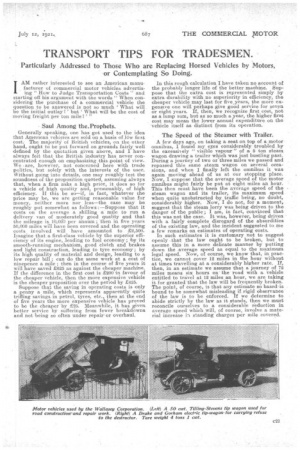TRANSPORT TIPS FOR TRADESMEN.
Page 17

If you've noticed an error in this article please click here to report it so we can fix it.
Particularly Addressed to Those Who are Replacing Horsed Vehicles by Motors, or Contemplating So Doing.
IAM rather interested to see an American manufacturer of commercial motor vehicles advertisMg " How to Judge Transportation Casts " and starting off his argument with the words" When considering the purchase of a commercial vehicle the question to be answered is not so much 'What will be the initial outlay?' but 'What will be the cost of moving freight per ton mile?
• .Saul Among 'the. Prophets.
Generally speaking, one has got used to the idea that American vehicles are sold on a basis of ldw first cost. The majority of British vehicles, on the other hand, ought to be put forward on grounds fairly well defined by the quotation given above, and I have always felt that the British industry has never concentrated enough on emphasizing this point of view. We -are, however, not concerned here with trade politics, but solely with the interests of the user. Without going into details, one may roughly test the soundness of the proposition quoted, assuming always that, when a firm asks a high price, it does so for a vehicle of high quality and, presumably, of high efficiency. If this be so—if, in fact, whatever the price may be, we are getting reasonable value for money, neither more nor, less—the case may be roughly put somewhat as follows :—Suppose that it cobts on the average a shilling a mile to run a delivery van of moderately good quality and that the mileage is 10,000 per annum ; 'then in five years 50,000 miles will have been covered and the operating costs involved will have amounted to 22,500. Imagine that a first-class vehicle by the superior efficiency of its engine, .leading to fuel economy ; by its smooth-running mechanism, good clutch and brakes and light construction, leading to tyre economy ; by its high quality of material and design, leading to a low repair bill ; can do the same work at a cost of ninepence a mile ; then in the course of five years it will have saved 2625 as against the cheaper machine. If the difference in the first cost is £200 in favour of the cheaper vehicle, then the more expensive vehicle is the cheaper proposition over the period by .E425. Suppose that the saving in operating costs is only a penny a mile, which represents apparently quite trifling savings in petrol, tyres, etc., then at the end of five years the more expensive vehicle has proved to be the cheaper. by E25. Meanwhile, it has given better service by suffering from fewer breakdowns and not being so often under repair or overhaul.
In this rough calculation I have taken no account of the probably longer life of the better machine. Suppose that the extra cost is represented simply by extra durability with no superiority in efficiency, the cheaper vehicle may last for five, years, the more expensive one will perhaps give good service for seven. or eight years. If, then, we recognize first cost, not as a lump sum, but as so much a year, the higher first cost may mean the lower annual expenditure on the vehicle itself as distinct from its operation.
The Speed of the Steamer with Trailer.
A fe-N days ago on taking a seat on top of a motor omnibus, I found my eyes considerably troubled by the excessively " visible vapour" of a 5 ton steam wagon drawing a trailer which was just bustling past. During a journey of two or threemiles we passed and repassed this same steam wagon OD several occasions, and when I finally left the omnibus it was again moving ahead of us at our stopping place. Now, I suppose that the average speed of the motor omnibus might fairly be put at eight miles an hour. This then must have been the average speed of the steam wagon and its trailer, its maximum speed when quite unobstructed by traffic being, no doubt, considerably higher. Now, I do not, for a moment, suggest that the steam lorry was being driven to the danger of the public ; I am, in fact., convinced that this was not the case. It was, however, being driven with a fairly complete disregard of the absurdities of the existing law, and the incident suggested to me a few remarks on estimates of operating costs.
In such estimates it is customary not to suggest openly -that the law ought to be broken, but to assume this in a more delicate manner by putting down the average speed as equal to the maximum legal speed. Now, of course, we know that, in practice, we cannot cover 12 miles in the hour without at times travelling at a considerably higher rate. If, then, in an estimate we assume that a journey of 72 miles means six hours on the road with a vehicle entitled to travel at 12 miles an hour, we are taking it for granted that the law will be frequently broken. The point, of course, is that any estimate so based-is bound to be somewhat misleading if. rigid observance of the law is to be enforced. If we determine to abide strictly by the law as it stands, then we must reconcile ourselves toa considerable reduction in average speed which will, of course, involve a material increase in standing charges per mile covered.
































